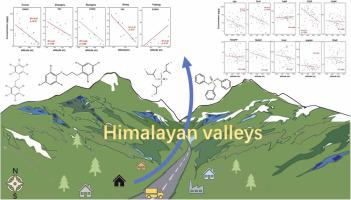当前位置:
X-MOL 学术
›
J. Hazard. Mater.
›
论文详情
Our official English website, www.x-mol.net, welcomes your
feedback! (Note: you will need to create a separate account there.)
The transport and distribution of novel brominated flame retardants (NBFRs) and organophosphate esters (OPEs) in soils and moss along mountain valleys in the Himalayas
Journal of Hazardous Materials ( IF 12.2 ) Pub Date : 2023-11-22 , DOI: 10.1016/j.jhazmat.2023.133044
Yu Chen 1 , Hao Xian 2 , Chengcheng Zhu 3 , Yingming Li 1 , Zhiguo Pei 1 , Ruiqiang Yang 4 , Qinghua Zhang 4 , Guibin Jiang 4
Journal of Hazardous Materials ( IF 12.2 ) Pub Date : 2023-11-22 , DOI: 10.1016/j.jhazmat.2023.133044
Yu Chen 1 , Hao Xian 2 , Chengcheng Zhu 3 , Yingming Li 1 , Zhiguo Pei 1 , Ruiqiang Yang 4 , Qinghua Zhang 4 , Guibin Jiang 4
Affiliation

|
Although the Himalayas act as a natural barrier, studies have demonstrated that certain traditional persistent organic pollutants (POPs) can be transported into the Tibetan Plateau (TP) through the mountain valleys. Herein, we selected five mountain valleys in the Himalayas to investigate novel flame retardants (NFRs), as representative novel POPs, their concentration, distribution, transport behavior, potential sources and ecological risk. The results revealed that total concentrations of 7 novel brominated flame retardants (NBFRs) ranged from 4.89 to 2853 pg/g dry weight (dw) in soil and from not detected (ND) to 4232 pg/g dw in moss. Additionally, total concentrations of 10 organophosphate esters (OPEs) ranged from ND to 84798 pg/g dw in soil. Among the NFRs, decabromodiphenylethane (DBDPE) and tri-phenyl phosphate (TPhP) were the predominant compounds. NBFRs and OPEs concentrations were slightly higher than those in the polar regions. The correlation between different compounds and altitude varies in different areas, indicating that the NFRs distribution in the mountain valleys result from a combination of long-range transport and local sources. The ecological risk assessment using risk quotient (RQs) revealed that TPhP and tris (2-chloroisopropyl) phosphate (TCIPP) exhibited medium or high risks at some sites. This study sheds light on the transport pathways and environmental behaviors of the NFRs in the valleys and highlights the need for increased attention to the ecological risks posed by OPEs in the TP.
中文翻译:

新型溴系阻燃剂 (NBFR) 和有机磷酸酯 (OPE) 在喜马拉雅山山谷土壤和苔藓中的运输和分布
尽管喜马拉雅山起到了天然屏障的作用,但研究表明,某些传统的持久性有机污染物 (POP) 可以通过山谷输送到青藏高原 (TP)。本文选取喜马拉雅山的 5 个山谷,研究了新型阻燃剂 (NFRs) 作为代表性的新型持久性有机污染物及其浓度、分布、运输行为、潜在来源和生态风险。结果表明,7 种新型溴系阻燃剂 (NBFRs) 在土壤中的总浓度在 4.89 至 2853 pg/g 干重 (dw) 之间,在苔藓中未检测到 (ND) 至 4232 pg/g dw 之间。此外,土壤中 10 种有机磷酸酯 (OPE) 的总浓度范围为 ND 至 84798 pg/g dw。在 NFRs 中,十溴二苯乙烷 (DBDPE) 和磷酸三苯酯 (TPhP) 是主要化合物。NBFRs 和 OPEs 浓度略高于极地地区。不同化合物与海拔高度之间的相关性在不同地区有所不同,表明山谷中 NFRs 的分布是远距离传输和本地来源相结合的结果。使用风险商 (RQ) 的生态风险评估显示,TPhP 和磷酸三 (2-氯异丙基) (TCIPP) 在一些地点表现出中度或高风险。本研究阐明了 NFR 在山谷中的运输途径和环境行为,并强调了需要更加关注 OPE 在 TP 中构成的生态风险。
更新日期:2023-11-22
中文翻译:

新型溴系阻燃剂 (NBFR) 和有机磷酸酯 (OPE) 在喜马拉雅山山谷土壤和苔藓中的运输和分布
尽管喜马拉雅山起到了天然屏障的作用,但研究表明,某些传统的持久性有机污染物 (POP) 可以通过山谷输送到青藏高原 (TP)。本文选取喜马拉雅山的 5 个山谷,研究了新型阻燃剂 (NFRs) 作为代表性的新型持久性有机污染物及其浓度、分布、运输行为、潜在来源和生态风险。结果表明,7 种新型溴系阻燃剂 (NBFRs) 在土壤中的总浓度在 4.89 至 2853 pg/g 干重 (dw) 之间,在苔藓中未检测到 (ND) 至 4232 pg/g dw 之间。此外,土壤中 10 种有机磷酸酯 (OPE) 的总浓度范围为 ND 至 84798 pg/g dw。在 NFRs 中,十溴二苯乙烷 (DBDPE) 和磷酸三苯酯 (TPhP) 是主要化合物。NBFRs 和 OPEs 浓度略高于极地地区。不同化合物与海拔高度之间的相关性在不同地区有所不同,表明山谷中 NFRs 的分布是远距离传输和本地来源相结合的结果。使用风险商 (RQ) 的生态风险评估显示,TPhP 和磷酸三 (2-氯异丙基) (TCIPP) 在一些地点表现出中度或高风险。本研究阐明了 NFR 在山谷中的运输途径和环境行为,并强调了需要更加关注 OPE 在 TP 中构成的生态风险。

































 京公网安备 11010802027423号
京公网安备 11010802027423号